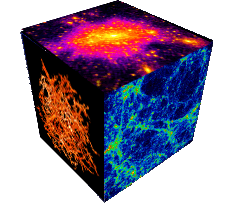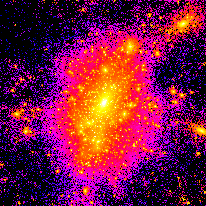
As dramatic advances in detector and telescope technologies make it possible to observe the Universe at a fraction of it present age, they also bring a sense of urgency to questions that only a few years ago seemed confined to the territory of theoretical speculation. How do cosmic structures form? How do they acquire their observed features?
The observed present-day features and forms of these wonderous cosmic sculptures are the result of a myriad of inter-related physical processes involving gas, stars, gravity, radiation, and dark matter, a mysterious form of matter that has so far escaped direct detection but makes its presence felt through its gravitational influence on its environs.
Of all the various elements of this fascinating cosmic kaleidoscope, I would argue that perhaps none is as intriguing as galaxies, like our own Milky Way, and dynamically stable galaxy swarms whose mass is equivalent to anywhere from 10,000 billion suns to a mind-boggling million billion suns. Not surprisingly, understanding how such systems came into being and why they possess the properties that they do is the key goal of my research efforts.
To understand how these various components mix and miggle, and give rise to the observed cosmic sculptures, my collaborators and I make use of powerful supercomputers to simulate the evolution of the Universe, replicating the Universe's 14 billion year history in anywhere from two weeks to several months, depending on the degree of detail that we wish to capture in the simulations.
The two video installations show movies made from outputs of two such numerical simulations. To preview the video clips [in quicktime format], click on the images below.
 The first installation traces the formation and evolution of a cluster of galaxies. For many years now, I have been working with Professor Tom Quinn of the University of Washington, Professor Neal Katz of the University of Massachussetts, Dr. Michael Balogh of the University of Durham, and two graduate students at the University of Victoria - Ian McCarthy and Greg Poole - to study the formation and evolution of such systems. This movie and the corresponding simulation were made by Professor Tom Quinn so that we could study how dark matter coalesces to form this massive system.
The first installation traces the formation and evolution of a cluster of galaxies. For many years now, I have been working with Professor Tom Quinn of the University of Washington, Professor Neal Katz of the University of Massachussetts, Dr. Michael Balogh of the University of Durham, and two graduate students at the University of Victoria - Ian McCarthy and Greg Poole - to study the formation and evolution of such systems. This movie and the corresponding simulation were made by Professor Tom Quinn so that we could study how dark matter coalesces to form this massive system.
At the earliest times, the distribution of matter is smooth except for tiny ripples with relative amplitudes of smaller than 1 part in a 100,000. Gravity amplifies these ripples to form the first generation structures, which under further influence of gravity over the course of roughly 14 billion years, merge to form successively larger systems until finally, the massive cluster emerges.
 The second installation can be thought of as zooming in on a pair of those tiny yellow objects in the first movie. These yellow objects are representative of galactic systems. During the cosmic merging process, it is not uncommon to have two simiar-sized galaxies come together to form a larger one. The image on the left shows a galaxy, the Antennae Galaxy, in the throes of such a merger. In fact, our own Milky Way and its nearest neighbour, the Andromeda Galaxy, are rushing towards
just such an embrace. I am collaborating with Professor Josh Barnes of the Institute for Astronomy at the University of Hawaii, Dr. Mark Fardal of the University of Victoria and Dr. James Taylor of the Oxford University to study the impact of mergers, large and small, on the process of galaxy formation. This particular movie corresponds to a simulation made by Professor Josh Barnes to study the general properties of an Antennae galaxy or equally, a Milky Way/Andromeda -like collision. Understanding this aspect of structure formation is key to understanding how galaxies like our own
Milky Way came into being.
The second installation can be thought of as zooming in on a pair of those tiny yellow objects in the first movie. These yellow objects are representative of galactic systems. During the cosmic merging process, it is not uncommon to have two simiar-sized galaxies come together to form a larger one. The image on the left shows a galaxy, the Antennae Galaxy, in the throes of such a merger. In fact, our own Milky Way and its nearest neighbour, the Andromeda Galaxy, are rushing towards
just such an embrace. I am collaborating with Professor Josh Barnes of the Institute for Astronomy at the University of Hawaii, Dr. Mark Fardal of the University of Victoria and Dr. James Taylor of the Oxford University to study the impact of mergers, large and small, on the process of galaxy formation. This particular movie corresponds to a simulation made by Professor Josh Barnes to study the general properties of an Antennae galaxy or equally, a Milky Way/Andromeda -like collision. Understanding this aspect of structure formation is key to understanding how galaxies like our own
Milky Way came into being.
Notice that as the emergent system in this movie tends towards equilibrium, it develops into a spheroid. Simiarly, during the intermediate phases in the [first] movie, the merging substructure organizes into filamentary structures. Such structures are not stable. In the absence of any specific constraints, very big gravitationally sculpted structures will tend to evolve into spheriods. Think of the shape of familiar cosmic objects such as the planets, the sun and the moon. They are all spherical.
An object's gravity tries to pull all of its material, be it rocks, stars, or dark matter, as close to its center as possible.
The outcome is a sphere.
